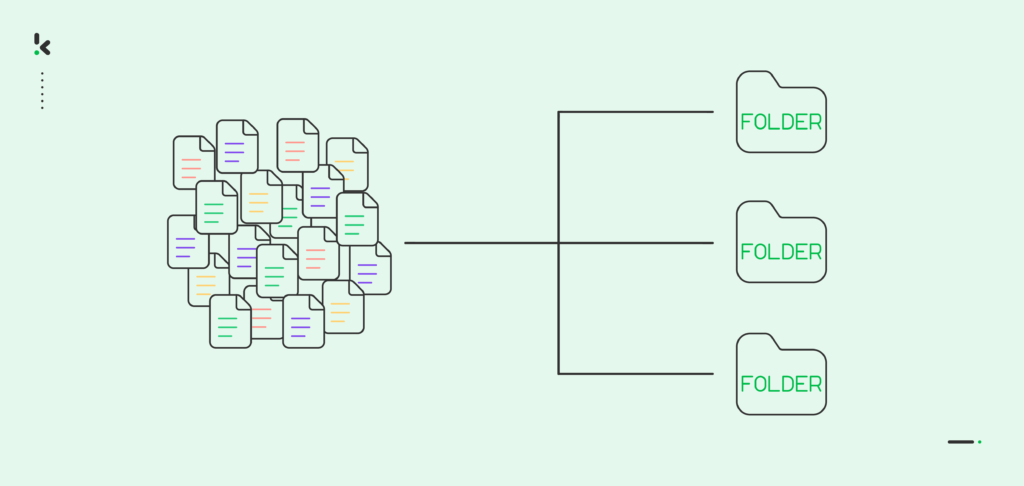

Efficient document archiving is essential for preserving the knowledge within your organization and ensuring regulatory compliance. Dealing with misplaced or lost documents can lead to not only daily frustrations but also hefty non-compliance fines and legal issues.
If you’d rather spend your resources on growth and innovation instead of managing the fallout from disorganized records, digital document archiving is what you need. It enables you to automate the entire process, from digitizing and processing to classifying and sorting.
In this blog, you’ll learn why you can’t pass up on automated document archiving, explore practical applications, and get step-by-step instructions for automating your own archiving workflow. Let’s get started!
Ready to dive in? Let’s get started!
What is Document Archiving?
Document archiving involves sorting and securely storing documents and information. Instead of traditional physical archives, many organizations now opt for digital archiving and automated document management for higher security and easier accessibility.
No matter what industry you fall into, you’ll need to archive documents to some extent. What makes digital document archiving a good fit? Let’s dive into some of the reasons in the following section.
Why Automate Document Archiving?
We all know that physical documents and traditional storage methods are vulnerable to destruction and deterioration. However, with automated document archiving, information remains accessible and retrievable, even over long periods.
Here’s why it’s such a game-changer:
- Compliance and Legal Obligations: Many industry regulations mandate archiving documents for specific periods. With automated document archiving, you can ensure the files are automatically stored, thereby protecting your business from non-compliance.
- Risk Mitigation: Digital document archiving allows you to minimize the risks of data loss, theft, or damage by protecting sensitive and important information within secure digital storage.
- Operational Efficiency: Automated archives streamline retrieval, enabling quick and efficient access to information. This boosts productivity, reduces search time, and improves decision-making with accurate, timely data.
- Enhanced Collaboration: Automated document archiving promotes knowledge sharing and collaboration within your organization. By centralizing and indexing documents, you can facilitate access to critical information, fostering innovation, problem-solving, and continuous improvement.
- Auditing and Accountability: Automated archiving offers a thorough trail to track documents and revisions over time. This fosters transparency, accountability, and compliance with policies and regulations within your organization.
Document archiving remains an important part of many businesses’ daily operations. But what does automated document archiving look like in practice? In the following section, we will explore common use cases to highlight its importance across different industries.
Uses Cases for Automated Document Archiving
Here are 5 real-life applications of what digital document archiving brings across different sectors:
Healthcare Industry: In the healthcare industry, automated document archiving ensures that all new information is instantly recorded and safely stored, maintaining continuous access to patient records, medical histories, and lab results, which are vital for preserving care continuity and complying with regulations like HIPAA.
Finance & Accounting: Financial service providers and accounting teams utilize digital archiving for transaction records and loan agreements, ensuring regulatory compliance and providing transparent audit trails of all financial operations.
Legal Industry: Legal professionals rely on digital archives for case files and contracts, supporting legal practice and client representation with critical reference material.
Public Sector: Government agencies employ digital archiving for policy records and public documents, promoting transparency and accountability in democratic processes. Alternatively, municipalities or museums tend to opt for digitizing historical knowledge, making it easily accessible for researchers and the public.
Educational Institutions: Educational institutions utilize digital archiving for student records and faculty publications, preserving institutional history and supporting academic research.
As you can see, any organization can benefit from automated document archiving! Regardless of your industry, proper and secure archiving is crucial. By using the right tools, like Klippa DocHorizon, you can streamline your workflow, ensuring that your archiving process is efficient, secure, and error-free.
How to Automate Document Archiving with Klippa
Klippa DocHorizon is your trustworthy partner for building digital archives with minimal effort. It’s an Intelligent Document Processing (IDP) platform with an intuitive low-code interface, empowering you to automate any of your document archiving workflows. Here’s how it works in just a few simple steps using Klippa DocHorizon:
Step 1: Set Up Your DocHorizon Account
To get access to the flow builder, you need to sign up to our DocHorizon Platform. Simply fill in your name and email address to get started. You will instantly receive a free credit of €25 to test the platform out.
Step 2: Select Your Input Source
If your documents are not digitized already, begin the process by scanning the documents you want to archive. Pro Tip: With Klippa’s mobile scanning SDK, you can capture your documents on the go with just a smartphone camera, ensuring the highest image quality. You can store the files in a cloud folder for easier access (it will come in handy in a bit!).
Once your files are ready, it’s time to start the workflow! Within the flow builder interface, the first step is to select the location of the files you want to extract the data from. Klippa DocHorizon platform supports parsing from the cloud, email, or even FTP. But for this example, we will be illustrating how to set up the flow using Google Drive, so if you’ve saved your files there, it’s as simple as connecting your Google account! Select “New File” from the list of actions to fire a trigger every time there’s new file to be processed for archiving.
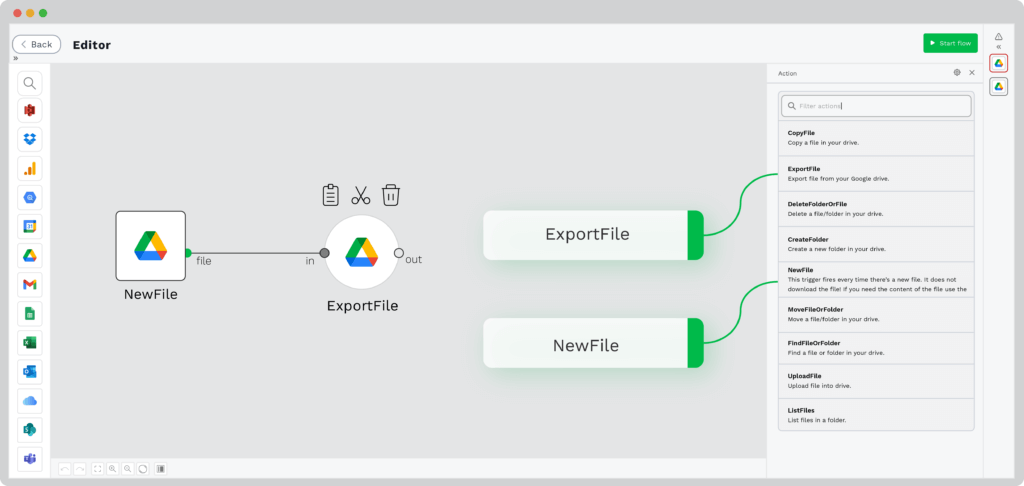

Step 3: Extract the Data
The next step is to extract the data from your files. Using the “Document Capture” component, you can select one of 2 options depending on the document type you wish to process. You can select “Financial document capture” or “Generic document capture” or customize what needs to be processed using our prompt builder.
For this example, we’ll use the “Capture Generic Model” – just connect the selected option to your Google Drive folder, and you’re good to go. The DocHorizon platform handles all the reading, capturing, classification, and data extraction for you.
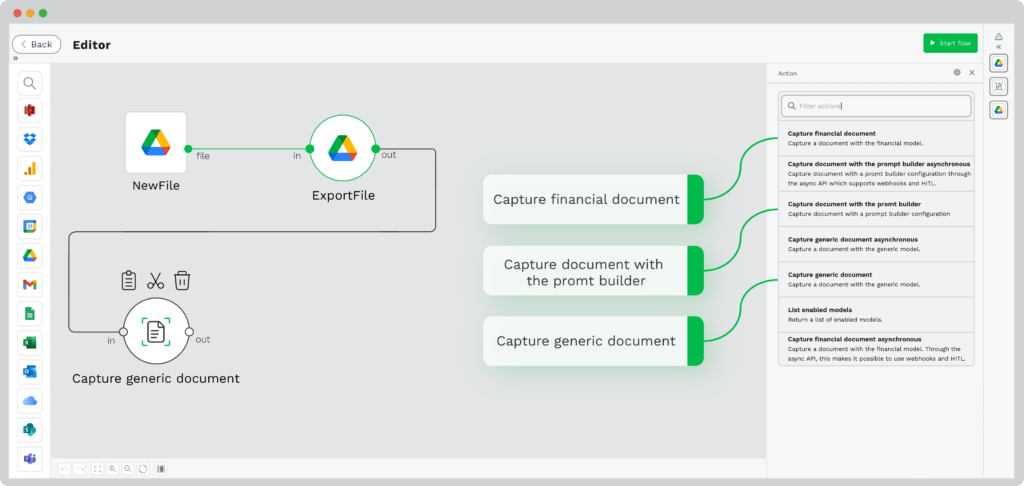

Step 4: Convert Data
Select the converter from the list of utilities to convert the extracted data from the document you wish to archive. You can convert your data into any format that best suits your needs – XML, XLSX, ZIP, and more.
Here, we’re going to show how to convert the data to ZIP format, so you can store it within the archived file. You can do this by selecting ZIP format from our converter component.
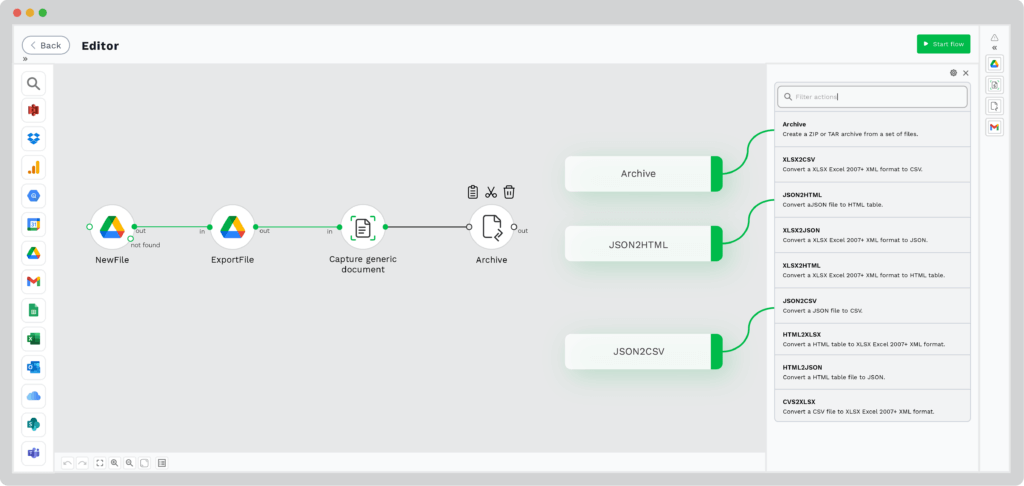

Step 5: Select the Output File Destination
Now that the document data has been extracted and converted, it is ready to be forwarded. You have a wide range of output destinations to choose from, including databases, ERP systems, CRM systems, various cloud storage services, archiving solutions, or even your own software.
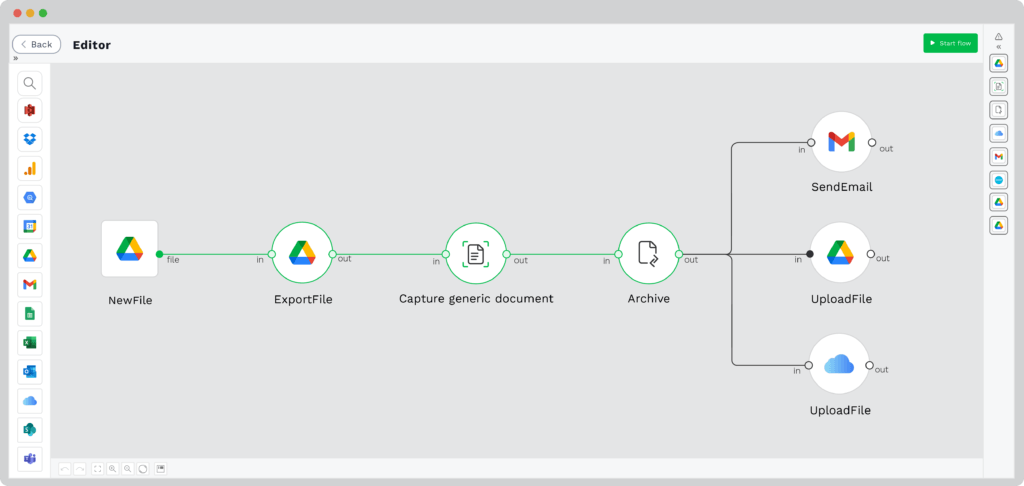

And that’s it! Your document data is safely stored in the digital space. If you want to learn more about smart document archiving, feel free to explore more of our content about automated document indexing, document sorting, or document classification.
For any additional information about the workflow, feel free to consult our extensive documentation.
Benefits of Automating Document Archiving with Klippa
Klippa provides you with the tools you need to automate all of your document workflows from document capture, conversion, and classification to archiving. Here are some of the benefits you get to experience with our digital document archiving solution:
- Improved Workflow Efficiency: Create custom workflows to automate various document-centric tasks to ensure precise document management without human error.
- Precise Data Extraction: With our built-in AI-powered Optical Character Recognition (OCR), you can accurately extract data from a wide range of document types in multiple languages, providing comprehensive support for all your archiving needs.
- Integration Capabilities: Our platform supports 50+ integration possibilities: cloud solutions, email providers for email parsing, CRM, ERP or accounting software, and more, for seamless integration with your current operational process.
- Compliance and Regulatory Adherence: Klippa’s solutions ensure compliance with privacy regulations like HIPAA and GDPR and protect any of your sensitive data with smart data anonymization capabilities.
- Security and Data Protection: Since Klippa is an ISO & GDPR-compliant provider, we don’t store any of your data and utilize advanced SSL encryption, guaranteeing that your data is safe.
By automating document workflows, you can enjoy the convenience and the power of AI to transform daily mundane tasks. Contact our experts or book a free demo down below!